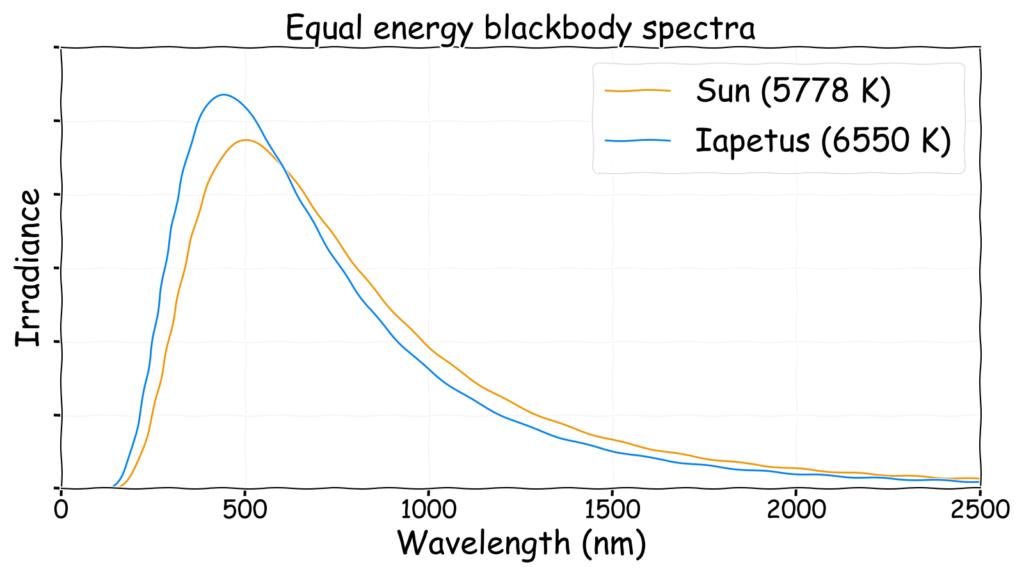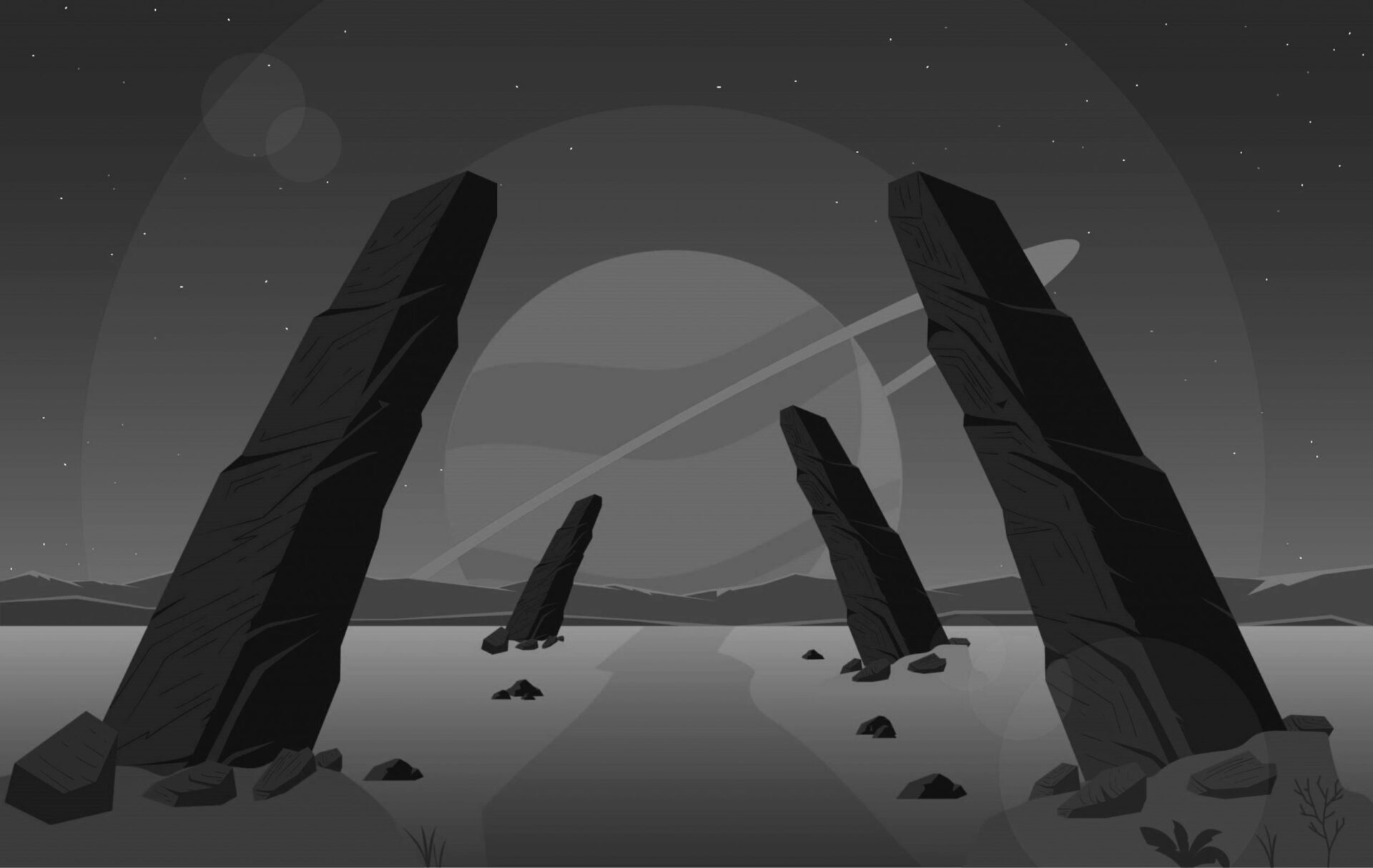Background
An aerial ecosystem on the planet Atlas was presented in episode 1 of the Netflix Alien Worlds show. However, in my opinion it did not go far enough so I thought I would conclude the series of articles on lighter-than-air gasbags by sketching out a world with a rich aerial ecosystem. This world is known as Epimetheus (since he was also a Titan and the brother of Atlas).
Epimetheus will not be Earth-like but will instead be tweaked to make gasbags more plausible. This first post will focus on the solar system and geography of the planet Epimetheus. The following two articles will cover Epimetheus’s climate and the biology of the aerial ecosystem that evolved there.
Star
Iapetus is an F-class main sequence star that is slightly more massive than the Sun. Specifically it is an F5V star with the following parameters where the ☉ symbol indicates units relative to the Sun.
- Mass: 1.33 M☉
- Radius: 1.47 R☉
- Temperature: 6,550 K
- Luminosity: 3.57 L☉
As Iapetus is more massive than the Sun it has a shorter expected lifetime. Despite being slightly younger than the Sun, at is therefore nearer the end of its life, though it will still be many years until it expands and becomes a red giant.
Since Iapetus is hotter than the Sun, its spectrum is shifted more towards bluer wavelengths and an increased amount of ultraviolet light. If a planet received the same total energy from Iapetus as Earth receives from the Sun it would receive a greater proportion of short wavelength light (e.g. ultraviolet). It would also receive less longer wavelength light (e.g. near infrared).

Planets
There are three planets of orbiting Iapetus, with a debris disc between the second and third planets that is similar to the Asteroid Belt in the Solar System. Beyond the third planet there is a second debris disk that resembles the Kuiper Belt. Within this second disc there are probably several icy dwarf planets orbiting at greater distances.
| Name | Mass | Radius | Semi-Major Axis | Eccentricity | Year |
|---|---|---|---|---|---|
| Prometheus | 3.5 M🜨 | 1.4 R🜨 | 1.3 AU | 0.002 | 469 d |
| Epimetheus | 3.0 M🜨 | 1.3 R🜨 | 2.8 AU | 0.003 | 1484 d |
| Klymene | 21.6 MJ | 1.0 RJ | 10 AU | 0.310 | 27.4 y |
Prometheus (Iapetus b) is a massive super-Earth which receives a lot of light from Iapetus due to its relative proximity. This caused its ample water content to boil and fill the atmosphere with steam. As water is a greenhouse gas this triggered a runaway greenhouse effect and now Prometheus is more accurately called a super-Venus. Perhaps life is possible somewhere in the clouds of Prometheus but certainly the surface is an uninhabitable furnace.
Epimetheus (Iapetus c) began life like Prometheus but since it is further away it could cool after formation and its water condensed into oceans. It has retained a thick carbon dioxide atmosphere that retains heat well despite being on the outer edge of the habitable zone. It has an axial tilt of 5° which produces minimal seasonal variation unlike Earth. It is orbited by two large moons (Pyrrha and Deucalion) along with a handful of insignificant rocks.
Klymene (Iapetus d) is an eccentric super-Jupiter with multiple moons of various sizes. It is assumed that several giant planets initially formed around Iapetus but shortly after formation the gravitational interactions caused all but one of the planets to be expelled from the system. This left Klymene on a distant but eccentric orbit. Due to its high mass and eccentricity Klymene often perturbs asteroids in either debris disc which can result in them heading inwards to potentially impact the inner planets.

Moons of Epimetheus
The inconsequential smaller moons of Epimetheus are rocky debris flung inwards by Klymene that have been captured rather than impacting the surface. The two larger moons may have been captured in this way but, due to their size, they may also have been formed from one or more devastating impacts with Epimetheus. This is equivalent to the giant impact hypothesis that attempts to explain where Earth’s moon came from.
| Name | Mass | Radius | Semi-Major Axis | Apparent Size | Orbital Period |
|---|---|---|---|---|---|
| Pyrrha | 0.4 ML | 0.8 RL | 269,100 km | 0.6° | 9.3 d |
| Deucalion | 1.9 ML | 1.2 RL | 480,500 km | 0.5° | 22.5 d |
Pyrrha (Iapetus c I) appears slightly larger in the sky of Epimetheus than the Moon appears in the sky of Earth despite being smaller than the Moon. This is because it is closer to Epimetheus and therefore has a much shorter orbital period.
In contrast Deucalion (Iapetus c II) appears about the same size as the Moon though it is just under twice as massive (similar to Jupiter’s moon Ganymede). This is because it is further away from Epimetheus than the Moon is from Earth. However, due to the high mass of Epimetheus it has a slightly shorter orbital period than the Moon.
Epimetheus
Day Length
One apparently unusual feature of Epimetheus is the exceedingly slow spin. This may have been caused in the distant past from the same orbital interactions that flung Klymene’s sister gas giants from the system. It is actually not surprising for exoplanets to have such slow spins, despite the rocky planets in the Solar System typically having faster spins.
Epimetheus takes around 85 Earth days to rotate once on its axis. This is the sidereal day which is the time taken for a star to return to the same location in the sky. In contrast, the resulting solar day which defines how long it takes Iapetus to return to the same location is around 90 days. Therefore, on the equator daylight lasts around 45 Earth days followed by 45 days of night.
Illumination
Despite orbiting a hot F-class star, Epimetheus’s distant orbit ensures it receives less illumination than on Earth. The solar constant at the top of the atmosphere is only 622 Wm-2 in contrast to 1,361 Wm-2 on Earth (i.e. 46%).
Surface
Since Epimetheus has a larger volume than Earth it also has a greater absolute amount of water. As volume is proportional to radius cubed but surface area is only proportional to radius squared this means the oceans tend to be deeper than on Earth.
In addition, the stronger surface gravity of Epimetheus (1.77 g) produces a reduced topographic variation relative to Earth. When these two factors are combined it ensures that Epimetheus is an ocean planet with little dry land.
The high mass of Epimetheus prevents plate tectonics from occurring and it exhibits stagnant lid tectonics instead. Small scattered land masses emerge from the waves where convective upwelling in the mantle causes the crust to bulge upwards or where volcanic activity bursts through the crust. Over geological time erosion and gravity will tend to wear these island down and return them to the sea.
Ocean
On Earth the motion of ocean tides is complex for two reasons. Firstly, the oceans are not deep enough to allow the water to move fast enough to keep up with the gravitational influence of the Moon (see shallow water gravity wave). Secondly, the presence of land has a massive effect of the tides.
In contrast, on Epimetheus neither of these situations are true. The deep water combined with the slower rotation means that water can keep up with the movement of the moons and there is minimal land to impede this. This means that simple equilibrium theory of tides is accurate for Epimetheus unlike the tides on Earth. An equatorial bulge therefore forms underneath each moon (and Iapetus) as the water is dragged around the equator.
The tidal period (i.e. time between sequential high tides) and tidal range (i.e. height different between high and low tides at the equator) of each contribution is shown below.
| Source | Tidal Period (d) | Tidal Range (m) |
|---|---|---|
| Iapetus | 45.1 | 0.01 |
| Pyrrha | 5.2 | 0.60 |
| Deucalion | 15.0 | 0.50 |
Unlike on Earth, the influence of Epimetheus’s sun is minimal because despite being more massive that the Sun it is much further away. In contrast each moon produces a tide generating force that is approximately the same as the Moon. However, due to Epimetheus’s slow rotation the tidal periods are much longer than Earth’s 12 hours and 25 minutes.
The combination of these factors produces a slowly varying but more complex tidal pattern than that experienced on Earth. Since daylight lasts for 45 days life in the intertidal zone will still experience several wet and dry cycles in a single solar day.

Atmosphere
Of the three planets around Iapetus only Epimetheus is suitable for life. This is because, despite being on the outer fringe of the habitable zone, Epimetheus has a thick carbon dioxide dominated atmosphere. The resulting potent greenhouse effect keeps the temperature suitable for liquid water. This atmosphere has been produced by volcanic outgassing from the hot interior due to the increased volcanic activity relative to Earth.
The atmosphere is primarily a stable mixture of carbon dioxide (CO2), nitrogen (N2) and oxygen (O2). The first two gases have been present in the atmosphere since formation though oxygen only appeared once life evolved oxygenic photosynthesis, as on Earth.
| Molecule | Pressure (bar) | Percentage |
|---|---|---|
| CO2 | 5.0 | 63% |
| N2 | 2.5 | 31% |
| O2 | 0.5 | 6% |
| Total | 8.0 | 100% |
At 0°C this produces a density of 13.72 kg/m3 in comparison to Earth’s air density of 1.27 kg/m3. This makes lighter-than-air gasbags much more viable on Epimetheus.
Other trace gases occur based on both volcanic and biological activity. In particular, sulfur containing chemicals are present in slightly higher concentrations than on Earth. These can form thin sulfur containing hazes in the atmosphere.
In addition, as an ocean planet the air is quite humid and water clouds are common. At higher altitudes the air is cold enough that carbon dioxide ice clouds also occur.
Summary
In summary, Epimetheus is a slowly spinning, high gravity ocean world with a thick carbon dioxide atmosphere.
- Orbits an F-class star
- Mass: 3.0 M🜨
- Radius: 1.3 R🜨
- Year: 1,484 Earth days
- Day: 90 Earth days
- Gravity: 1.77 g
- Solar Illumination: 46% Earth
- Atmosphere: 8 bar (CO2 dominated)
Epimetheus is perhaps optimal for the evolution of an aerial ecosystem based on lighter-than-air gasbags. The gravity is strong at 1.77 g but as previously seen that doesn’t influence buoyancy. However, the thick 8 bar atmosphere is over 10 times denser than on Earth. This allows a hydrogen filled balloon to generate about 11 times as much lift as on Earth.
The second article on Epimetheus will describe the general climate, followed by the final article describing some of the life forms that have evolved and thrive on Epimetheus.

Kudos on the impressive level of detail here. I love seeing hypothetical worlds that aren’t overly similar to Earth.
I’ve been using the “Gasbags” series as a guideline for my own (rough) sketch of an aerial ecosystem, so I’m curious to see if our ideas end up being convergent at all, even with different planetary parameters. Either way, these articles have been great.
Thanks. I get easily distracted reading scientific literature and end up with a lot of related ideas bouncing around in my head. I then find it an interesting challenge to pull them all together to make a coherent and plausible world. It’s rewarding to think that somewhere out there a planet like this might actually exist though.